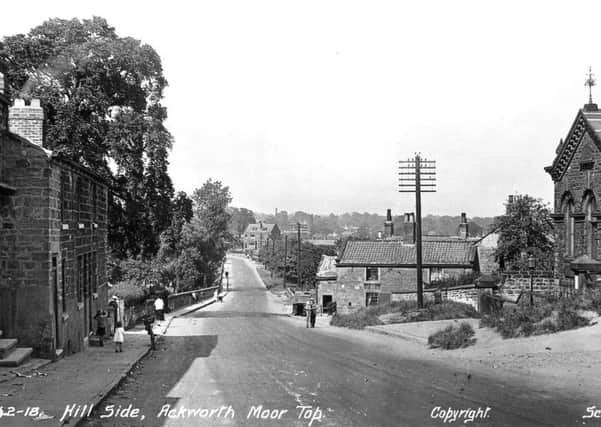Nostalgia on Tuesday: Built on history


Ackworth was possibly a Roman settlement as there is evidence of a smelting works within the village which, itself, probably came into being during the Anglo Saxon period.
There are possibly two ways the name has been derived. First, from the Anglo Saxon words ‘Ake’ or ‘Aken’ meaning ‘oak’ and ‘uurt’ or ‘worth’ meaning a clearing, homestead or enclosure. Alternatively, it may come from the Anglo Saxon name ‘Acca’ and when added to ‘worth’ could suggest ‘Acca’s worth or ‘Acca’s enclosure’.
Advertisement
Hide AdAdvertisement
Hide AdThe first Ackworth church was established around the eighth century and the monks of Lindisfarne are believed to have stopped there with the body of Saint Cuthbert around 875. They had fled when the Danes took the Lindisfarne monastery, carrying with them St Cuthbert’s body around a number of locations. The church of St Cuthbert in the centre of Ackworth is believed to have taken its name from this.
In the 1086 Domesday Book, Ackworth is recorded as Aceuurde with two manors (High and Low Ackworth) which has been developed over the centuries to its present title. The area was mentioned with a church, a priest and a mill and populated by about 40 inhabitants.
Ilbert de Lacy was in control of Ackworth, being under the Honour of Pontefract, after the 1066 Norman invasion. Hugh de Laval gave the church to Nostell Priory around 1119-1129 and this lasted until the dissolution of the monasteries. A Chapel of Our Lady was founded in Ackworth Church in 1333 by Isabella de Castleford.
Speculation surrounds the date of the village cross. Pevsner in Yorkshire The West Riding (1959) offers the following: “On the Village Green Churchyard Cross, that is medieval shaft with Tudor ball on top’. Allegedly, a cross on top of the shaft was knocked off by Cromwell’s Roundhead troops when in 1648 they were occupying Ackworth. It was subsequently replaced by a ‘ball’ symbol of the world.
Advertisement
Hide AdAdvertisement
Hide AdEarlier, the Bubonic Plague of 1645 drastically affected Ackworth as it did many other communities. Approximately 153 people suffered and died in Ackworth. Victims were buried close to a ‘burial field’, where it is believed victims from an English Civil War battle were already interred. A ‘Plague Stone’ at the top of Castle Syke Hill leading from Ackworth to Pontefract is a reminder of how for many months this was the only contact between the village and the outside world. The stone is said to date from an outbreak of plague in 1705.
A significant development took place in Ackworth during the mid-18th century with the establishment of a Foundling Hospital, as an appendage to the one in London. Construction of the Ackworth site stretched from 1757 to 1762.
The hospital lasted until September 1773 after taking care of more than 2,600 children. Six years later, Ackworth School was founded on the site by eminent physician John Fothergill on behalf of the Quakers. Those educated at Ackworth included poets Jeremiah Holmes Wiffin and Bernard Barton and writer William Howitt.
A colourful character, John Gully, arrived in Ackworth in the 1830s having acquired Ackworth Park, erected around 1630. He was a former English prize-fighter, horse racer and politician who sat in the House of Commons from 1832 to 1837 for the Pontefract constituency. In 1862 he purchased the Wingate estate and collieries and died in Durham in 1863, but is buried at Ackworth.
Advertisement
Hide AdAdvertisement
Hide AdA Roman Catholic church was built in Ackworth during 1840 in the Gothic Style while St Cuthbert’s Church was rebuilt in stone in 1855. The church is adorned with a number of stained windows and is rich in carved oak. A figure of St Cuthbert was placed in the niche of the porch. The new church was designed by J W Hugall, a British Gothic Revival architect who spent the early part of his career in Pontefract. The church of All Saints was erected at Ackworth Moor in 1889-91 as a chapel of ease to St Cuthbert’s.
Other churches included a Wesleyan chapel, a meeting house for the Society of Friends at Low Ackworth and a Primitive Methodist chapel at Moor Top.
Besides agriculture, stone quarrying had been developed in the Ackworth area, particularly Brackenhill and from the mid-19th century coal mining was developed on a significant scale with Acton Hall colliery (or Featherstone Manor colliery) and Hemsworth colliery being sunk.
Cutting through the village are two roads – the A638 from Wakefield to Doncaster and the A628 from Barnsley to Pontefract. During the coaching era stagecoaches passed through stopping at the Angel pub and the Boot and Shoe. Motorbuses then ran constantly to Pontefract, Wakefield, Leeds and Barnsley.
Advertisement
Hide AdAdvertisement
Hide AdAckworth was connected to the railway network on July 1, 1879, with the opening of a station on the Swinton and Knottingley Joint Railway. The station, located in Low Ackworth, closed to passengers in 1951, and closed altogether in 1959.
Over the last half-century, occupations for people living in Ackworth have altered considerably particularly with the demise of quarrying and mining. But the spiritual needs of the community, catered for since the time of the Anglo Saxons, still thrive today. Education has been a feature, and of a high standard, since the mid-18th century and that also continues.